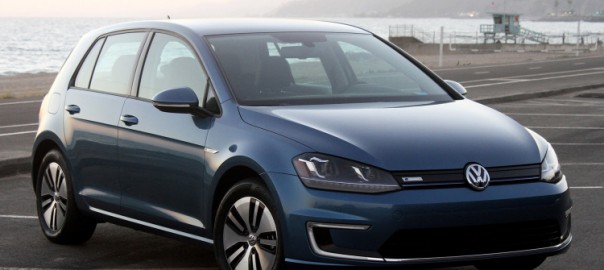Electrified Golf Is The EV We Could Live With
Until now, the only way you could get the words “electric” and “Golf” so close together was the put the word “cart” after them. Knowing that the e-Golf would be the next step in Volkswagen’s tilt at electrification, the automaker designed the MkVII platform to fit a myriad of drivetrains, none of which would require purchasers to sacrifice the Golf-ness that makes the best-selling car in Europe, not to mention a huge hit here in the States. In the e-Golf that means power electronics underhood and an amoeba-shaped battery that fits in the floorpan, between the axles, where it won’t ooze into the interior space.
We look at the e-Golf as another kind of crossover: traditional cars that just happen to be electric, offering a taste of the new EV religion in soothing, recognizable garb. We had one for a week in its natural habitat, Los Angeles and the surrounding area. We really like the fact that, powertrain aside, it maintains everything we dig about the Golf. The caveat is that this is an EV first and a Golf second – you must first address the EV challenges and live within EV constraints, then you can enjoy the Golf bits. Even so, it’s the electric car this writer would buy once we acquired the lifestyle to make proper use of it.

The most noticeable exterior change to the e-Golf are 16-inch Astana wheels wrapped in 205-series tires that reduce rolling resistance by ten percent. Once you’ve cottoned on to that, the other alterations become apparent: the blue trim strip underlining the radiator grille, the redesigned bumper with the C-shaped decoration LED lights and the full-LED headlamps above them, the little blue “e” in the model name on the rear hatch. You won’t notice the underbody paneling, that the frontal area of the e-Golf is ten percent smaller than that of a traditional Golf, that the radiator is closed off, or the reshaped rear spoiler and vanes on the C-pillars. Volkswagen says this results in a ten-percent drop in drag, getting the coefficient down to 0.281, but the standard Golf is also listed at 0.28. The TSI and TDI are 0.29. No matter those numbers, the point is the e-Golf looks just like… a Golf.
The 12,000-rpm, 85-kW electric motor equates to 115 horsepower and 199 pound-feet of torque, which compares to 146 hp and 236 lb-ft from the 2.0-liter diesel Golf. It takes 4.2 seconds to get to 37 miles per hour, 10.4 seconds to hit 62 mph, and the little guy tops out at 87 mph. That sounds like slacker acceleration, but it never feels that way – you can pull away from a light with the rest of traffic, and any time you need a squirt, 199 lb-ft of instant torque is there to woosh you forward.
Read more: Autoblog
